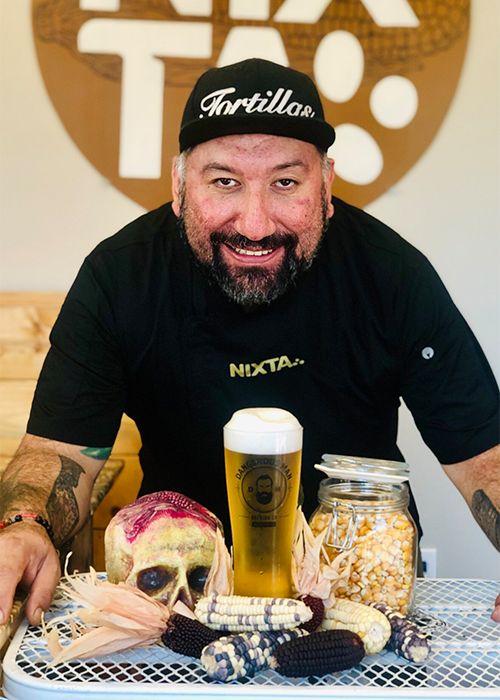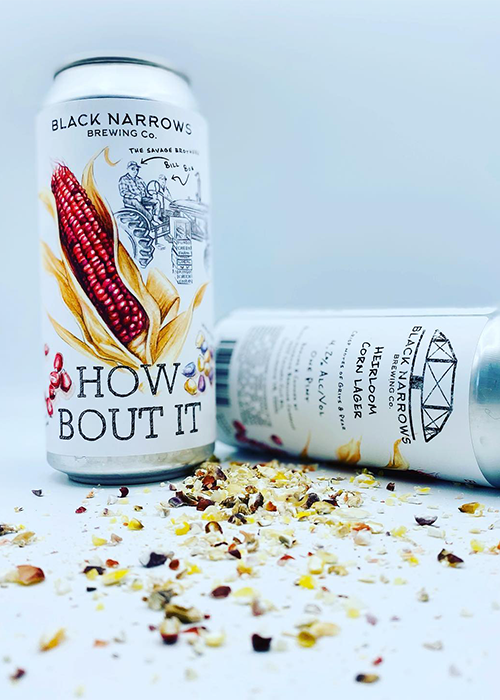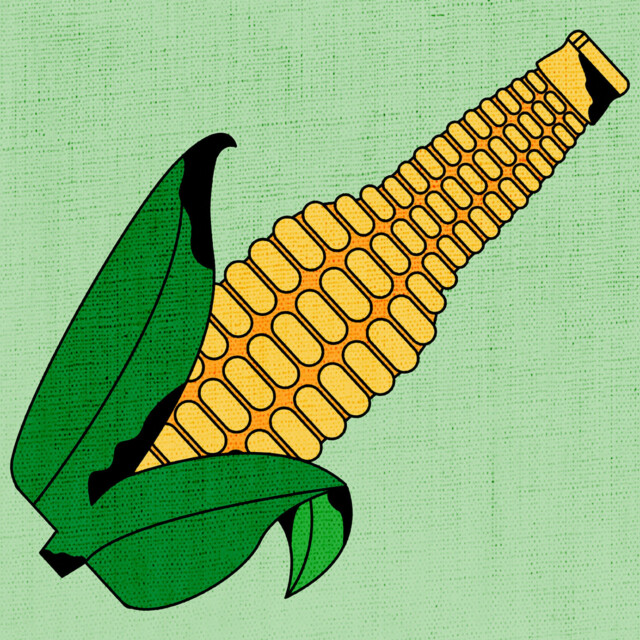In the bucolic hamlet of Accord, snug in New York State’s agrarian Hudson Valley, Arrowood Farms views brewing as an opportunity for growth. The farm brewery cultivates hops, grains, herbs, and produce used in its farmhouse ales, pilsners, and IPAs, in addition to sourcing ingredients from local farmers.
“We never go out of state for an ingredient,” says Jacob Meglio, a founder and the managing partner. The brewery keeps close eyes on what’s growing well, looking for ingredients that might make great beer. In particular, “there’s so much good corn being grown in New York.”
Last summer, Arrowood incorporated corn into the crushable Cicada, a local riff on the archetypal American lager. Cicada drinks clean and crisp, exactly what you’d crave while cutting grass or catching a baseball game. Arrowood highlights the signature ingredient right on the label, proudly calling it a corn lager.
“People are starting to realize that there’s something to craft adjunct lagers,” Meglio says.
American craft brewing is synonymous with ingenuity and infinite innovation, no ingredient too odd to lob into a brew kettle. Buoyed by hop-charged IPAs and dessert-style stouts, breweries long swam against the cold and bubbly currents of mainstream lagers laced with rice and corn products. No sense making the same beer as the big guys.
But after decades of dismissal, American craft breweries have stopped giving lagers the cold shoulder. In search of wider audiences, breweries are embracing broadly appealing lagers that contain corn, turning that summertime staple into a centerpiece ingredient.
Digging Up Heirloom Varieties of Corn
As a lager ingredient, corn’s rehabilitation tour is 10 years in the making. In 2012, the Brewers Association blasted brewers for making beers with adjuncts, or nonessential brewing ingredients, such as rice and corn that can lighten a beer’s body and add smooth sweetness. The trade group deemed that brewers making mostly adjunct beers were nontraditional, including Anheuser-Busch InBev and D.G. Yuengling & Son, which dates to 1829.

Blacklisting breweries over corn contradicted America’s beer-making traditions. During the 19th century, German brewers found America’s protein-rich, six-row barley created harsher lagers prone to haze. Without ready access to two-row barley, the favored European variety, brewers embraced corn and created the lasting template for the quintessential American lager.
The Brewers Association tweaked its tune in 2014 to let craft brewers use adjuncts, but that kernel of appreciation didn’t repair corn’s reputation. Case in point: Bud Light’s 2019 Super Bowl commercial decrying Miller Lite and Coors Light for using corn syrup.
“For a long time, corn has had such a bad rap in terms of beer,” says Todd Steven Boera, a founder and the creative director of Fonta Flora Brewery in Nebo, N.C. “But if you just dig a little bit, there’s quite another story to tell.”
Most cornfields are earmarked for fuel and animal feed. Field corn, as it’s called, is commonly farmed as a monoculture, one variety stretching into the distance as you drive past the fields. Corn is often viewed as a single vegetable, but it’s actually incredibly diverse. The International Maize and Wheat Improvement Center in Mexico City contains more than 28,000 varieties of corn, a constellation of recipe possibilities. “There’s so much variety in corn that people have no idea about,” says Ryan Shocklee, vice president of operations at Trillium Brewing.
Fonta Flora brews several lagers with heirloom varieties of corn including Cateto Orange, which originated in South America where it was grown in Brazil and Argentina in the late 19th century. Fonta Flora features Cateto Orange in its Lake James series of heritage lagers, including lime and watermelon versions. Each label prominently displays a corn cob. “We’re getting more cool varieties of corn into people’s hands,” Boera says.
In Minneapolis, Dangerous Man Brewing partnered with the nearby Nixta Tortilleria to create Heirloom Sipper, a lager produced with yellow, pink, red, white, and blue Mexican corn that was nixtamalized to boost its flavor. Bierstadt Lagerhaus, in Denver, partnered with local bar Finn’s Manor to make Heirloom Corn Lager with mauve Bolita Belatove and blue Bolita Azul corn from Oaxaca, Mexico. And since 2017, Black Narrows Brewing in Chincoteague, Va., has brewed How Bout It with locally grown Bloody Butcher corn.
Boston-born Trillium might be best known for its hugely aromatic hazy IPAs, but “we were founded as a modern New England farmhouse brewery,” Shocklee says. Now that its farm in North Stonington, Conn., is in its third planting season, the brewery is at last articulating its vision of local beer. This spring, Trillium released Crib, a “New England corn lager” featuring estate-grown Hopi Blue corn, an indigenous variety developed by Native American tribes.
“We’re able to reconnect the past to the present,” says Matt Garstka, Trillium’s marketing and communications manager.
Trillium also brewed Crib with pilsner malt produced by Valley Malt, a Massachusetts malt company that’s been instrumental in supplying malted corn for New England brewers. Wormtown Brewing in Worcester, Mass., features Valley Malt’s corn in its Mass Whole Lager, while Exhibit ‘A’ Brewing in Framingham, Mass., adds it to the Right to Farm Mexican-style lager.
“There’s a lot of time and money that’s put into trying to develop a market for something like malted corn,” says maltster Andrea Stanley, a founder of Valley Malt. “Corn lagers lend themselves to this effervescent palate that is gaining momentum.”
Summer Is Here. Time to Crack a Corn Lager
Maybe it’s all that corn at farmers markets and cookouts, but summer has emerged as the favored season to sip corn lager.
In 2013, John Martin, the president and head brewer of Confluence Brewing in Des Moines, Iowa, began making a lager with New Mexico-grown organic blue corn, which lends an appealing sweetness and helps round out the refresher. “We’ve had some hot weather lately, and Blue Corn Lager tastes really good,” says Martin, who also makes a version spiced with roasted jalapeños and ancho chiles.

Back in 2019, Fair State Brewing Cooperative partnered with Modern Times to create Crankin’ Foamers, an “American slammin’ lager beer” that contains corn. “The beer was set up as a summer thing,” says Niko Tonks, a Fair State founder, right down to the red, white, and blue label. It’s summertime in America! Let’s crush some lager!
“Everybody just flipped their shit for it,” Tonks says.
Crankin’ Foamers wasn’t an ironic lark. Fair State and Modern Times approached producing the beer with an eye toward “being as intentional and wonky with the process as we are with our German lagers,” Tonks says, including boiling corn grits in a process called cereal mashing, as well as a lengthy stay in horizontal lagering tanks.
When the world went haywire in 2020 and “all anybody wanted was as much beer at a reasonable price as they could possibly get,” Tonks says, Fair State decided to package Crankin’ Foamers in 12-packs of cans. The corn lager became a year-round offering, but consumer behavior is fickle. Sales of Crankin’ Foamers are stronger in the summer, before slowing in cooler months. Gathering around a fireplace instead of a campfire with an icy corn lager isn’t quite the same. “The truth is, it may honestly be our summer beer,” Tonks says.
Fonta Flora’s Boera also sees corn-lager sales dip in tandem with temperatures. “We just don’t see that same amount of love toward a straight corn lager in the colder months,” he says.
That’s to be expected. Beers tied to produce are most popular in their growing season. We sip pumpkin beers while the gourd fills fields in the fall. Maybe summer can be the official season of corn lagers, an approach that Fonta Flora will be taking next year.
The brewery is discontinuing several of its Lake James lagers made with heritage corn, including the stronger Ice and lower-alcohol Lite, and is earmarking its fruited Lime and Rind versions for summer. “Those are just our powerhouses during the summer months,” Boera says.
This story is a part of VP Pro, our free platform and newsletter for drinks industry professionals, covering wine, beer, liquor, and beyond. Sign up for VP Pro now!
